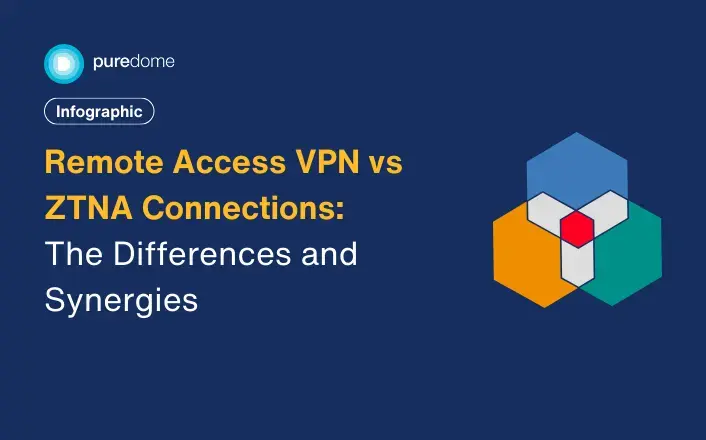- Product
-
Solution
-
By Industry
Cybersecurity solutions tailored to your industry’s needs.
-
- Resources
-
Books
Our ultimate guides and playbooks
Solution Briefs
Overview of PureDome’s functionality
-
Quizzes
Assess your cybersecurity readiness
Case Studies
PureDome customer success stories
Newsletter
Subscribe to the PureDome newsletter
-
- About Us
- Partner
- Pricing
- Download
Remote Access VPN vs ZTNA Connections - The Differences and Synergies
-
Aiman Ikram
-
30 Jan 2024
- 1 min read

.webp?width=1728&height=836&name=cover%201%20(6).webp)
VPNs were first introduced by Microsoft in 1996 to create a secure private connection between a user’s device and the internet. They were adopted for network security by businesses in the early 2000s, and while they were used for decades as cybersecurity heroes, corporate VPNs are now a retiring entity that can’t meet the needs of today’s cloud-centric and mobile-first world. Fortunately, a new secure remote access model has evolved to meet these needs - cue Zero Trust Network Access (ZTNA).
Here’s an infographic to lay out everything you need to know about what’s common between VPNs and ZTNA and what sets them apart.

What's The Final Verdict?
Remote access VPNs have not suddenly gone extinct as they continue to offer a sophisticated level of security for corporate networks and remote teams. Yet, like most other security-aware businesses, you too will want to consider ZTNA for providing advanced secure remote access in the cloud-centric, work-from-anywhere era. You don’t have to let go of your VPN to adopt ZTNA - it can coexist with other security solutions with ease.
Moreover, to ensure optimal protection, you must consider a cybersecurity partner based on your expertise in ZTNA implementation, compliance with regulatory standards such as HIPAA, and commitment to proactive threat detection and mitigation.
Interested to learn more? Here’s another infographic on factors to define before choosing a VPN.
Stay up to date with the latest cybersecurity insights and best practices
Get the latest information, stories, and resources in your inbox. Subscribe for monthly updates.
Securing 1000+ Businesses Across The World